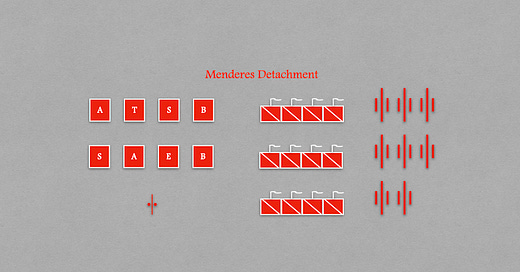In February of 1913, the headquarters in charge of Ottoman military forces on both sides of the Dardanelles, the Çannakale Straits Forces and Fortifications Command, possessed sixteen squadrons of cavalry.1 One of these was the single organic squadron of the 27th Nizam Division. Three were independent squadrons that reported directly to the general officer commanding the formation, Brigadier General Fahri Pasha. The twelve remaining squadrons belonged to a one-of-a-kind organization called the Menderes Detachment.2
Assembled for service on the Asian side of the Dardanelles, the Menderes Detachment also possessed eight territorial (redif) infantry battalions, eight batteries of field artillery, and a single company of machine guns. It was thus well suited for its definitive task of locating any hostile landing force that came ashore along the long coast south of the straits and delaying it until Ottoman infantry divisions arrived.
Source: Hans Rohde, Die Operationen an Den Dardanellen im Balkankriege 1912/13 (Berlin: R. Eisenschmidt, 1914), pages 132-136
For further reading: Edward Erickson’s examination of the great events of 1915 and 1916, Gallipoli: The Ottoman Campaign, begins with a brief but informative précis of the fight for the Dardanelles in 1913.
Çannakale, which also served as the name of the largest town on the straits, is the Turkish word for “Dardanelles.”
Menderes is the Turkish word for a meandering river that empties into the Aegean Sea south of the Straits. Indeed, it is from the Greek name for this serpentine watercourse that we get the English verb “meander.”






